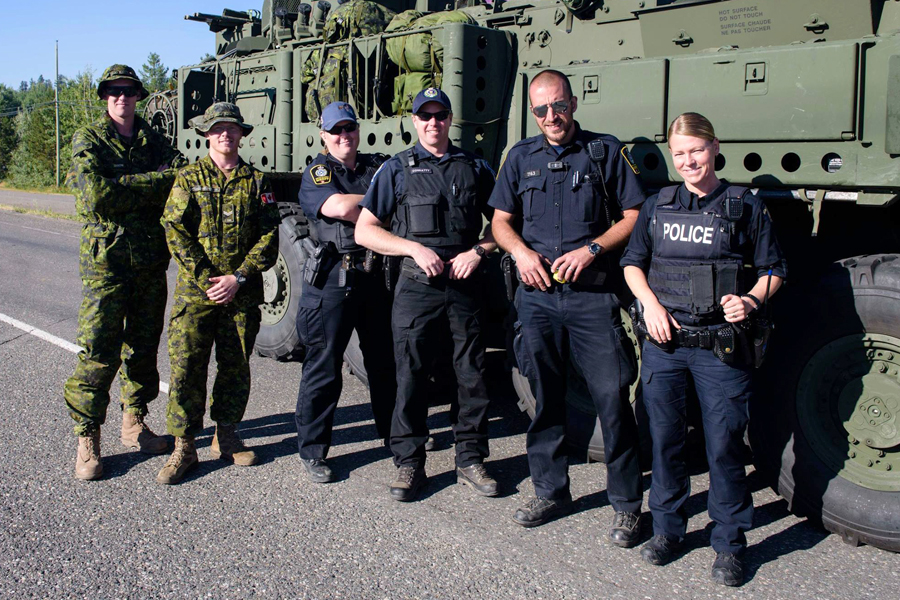RCMP and CAF team up to help B.C. residents
By Lookout on Aug 29, 2017 with Comments 0

Members of the Canadian Armed Forces and RCMP are working together to help B.C. residents as part of the ongoing emergency response to the wildfire threat. Photo by MCpl Malcolm Byers, Wainwright Imaging Services
Capt Jeff Manney
Op Lentus Land Task Force (Pacific) Public Affairs ~
The Canadian Armed Forces (CAF) say the Light Armoured Vehicle (LAV 6), with its thermal imaging camera and ballistic-steel hull, is “designed to operate in the world’s hot spots.” Well, they certainly got that right.
LAVs and their military crews are currently at work in B.C.’s fire-ravaged interior, where more than 1.1 million hectares have burned to date in the worst wildfire season in the province’s history.
Instead of conducting battlefield reconnaissance, they’ve been supporting RCMP and provincial authorities, monitoring evacuation perimeters, looking for looters at night and using their vehicles’ advanced thermal imaging system to help firefighters better protect communities.
“The assistance of the CAF has been absolutely essential,” said RCMP Sergeant Aaron Sproule. “Their ability to quickly mobilize large amounts of equipment and personnel has been a crucial part of ensuring the safe notification of residents when fire evacuation orders are issued by local governments. This has been especially true when the evacuation orders were applied to some of the more remote regions.”
LAVs aren’t the only asset designed for the battlefield that are at work this summer in B.C. Nearly 500 soldiers are deployed to Williams Lake on Operation Lentus, the Canadian Armed Forces effort in the ongoing emergency response to the wildfire threat.
Soldiers are staffing observation and reporting points with their RCMP colleagues, providing information to the public and helping support evacuations.
“We train to survive in an austere environment,” said Captain Rico Spiller, an infantry officer with the 3rd Battalion, Princess Patricia’s Canadian Light Infantry. “We’re self-sustaining, so we don’t need much to manage, and we’re suited to working outside for extended periods of time. That’s been key to maintaining continuity at the observation and reporting points.”
Yet another vital mission for Spiller and his team is the identification of helicopter landing sites. With high winds and extreme temperatures making fire movement unpredictable, it’s not enough to know the available road exits. The last, and most important, escape route is by air.
Should people on the ground be in danger, the RCMP can call upon one of the CAF’s CH-147F Chinook heavy lift helicopters. The Chinook can race to a landing site at over 300 km/h, and carry as many as 45 passengers to safety.
Finding these landing sites has been made easier by another unique military capability – the Canadian Ranger Patrol Group. Forty-seven Rangers from the 4th Canadian Ranger Patrol are now in Williams Lake.
A sub-component of the Reserve Force, Rangers hail from remote regions. They’re lightly equipped, self-sufficient and familiar with local geography. The Op Lentus Ranger Force came from communities throughout Western Canada, and they bring experience that further strengthens the RCMP-led effort.
“They have a set of secondary skills that we may not have,” says Spiller. “Some are paramedics, some firefighters, many are from local area First Nations. Their survival skills and knowledge of the land are significant.”
With persistent hot and dry conditions, the 2017 wildfire season is far from over. Without a significant change in weather conditions bringing sustained rainfall, there is every indication that Operation Lentus will continue through the end of August and well into September. The caf will remain on task as long as it takes, assisting provincial and local authorities in their emergency response, and reassuring residents living in affected areas.
Filed Under: Top Stories
About the Author:





